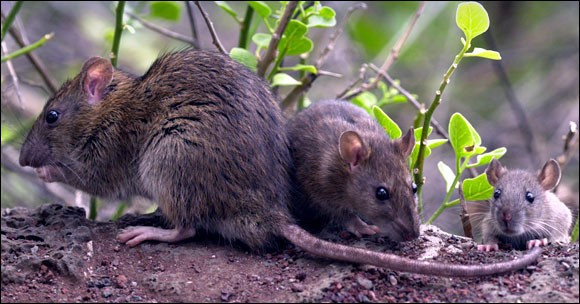180 Million Rats on Galapagos Islands to be Killed

Approximately 180 million rats, on the islands of Pinzon and Plaza Sur (of the famous Galapagos Islands archipelago), are to be exterminated. Environment authorities working with and for the Ecuadorian government, to whom the islands belong, say the rats are a non-native and invasive species that now threaten the existence of native and rare flora and fauna on the islands.
The Galapagos archipelago is famous for a wide variety of endemic species of plants and wildlife. The fact of the geographic isolation of the islands, as well as those of contributing geophysical and climatic forces, allowed life to evolve in unusual and unexpected ways. The entire area, therefore, served as the perfect research station for Charles Darwin and the discovery of the theory of evolution by natural selection, during his visit in 1835.
Norway and black rats, however, are not native to the island and Ecuadorian authorities say the rats endanger the existence of unique species like lava lizards and the giant tortoise. They further add the rats were probably introduced to the island during the late 17th century, by whalers and pirates who docked at the islands and should therefore not even be on the islands.
"The unique isolation of the Galapagos Islands has led to the evolution of species found nowhere else on earth. This same isolation makes the Galapagos especially vulnerable to the threat of invasive species," Nature Conservancy, a nonprofit conservation group involved in the eradication operation, explains.
The organisation also adds human-assisted action has led to an alarming increase in the rate of invasive species reaching the island, from an estimated one new species every 10,000 years to about 10 species a year during the last twenty years.
"It's one of the worst problems the Galapagos have. (Rats) reproduce every three months and eat everything," Juan Carlos Gonzalez, a specialist with Nature Conservancy, was quoted as saying to Associated Press.

In addition to being generally destructive, the presence of non-native rat species also directly harms the existence of native species of the same animal.
"The last endemic mouse on Santa Cruz (Nesoryzomys indefessus) was captured in 1934. Their extinction was most likely due to the introduced black rat, by spreading diseases and/or by competing for space and food, as well as by the feral cats on the island," Galapagos National Park authorities explain.
The entire operation, to be held through till the end of November, has been dubbed South America's largest ever "raticide" and will employ nearly 22 tons of poisoned bait, to be dropped by helicopter. Furthermore, the operation also involved the capture of 34 hawks and 40 iguanas from Plaza Sur, to stop them eating the poisoned rats.
© Copyright IBTimes 2025. All rights reserved.






















